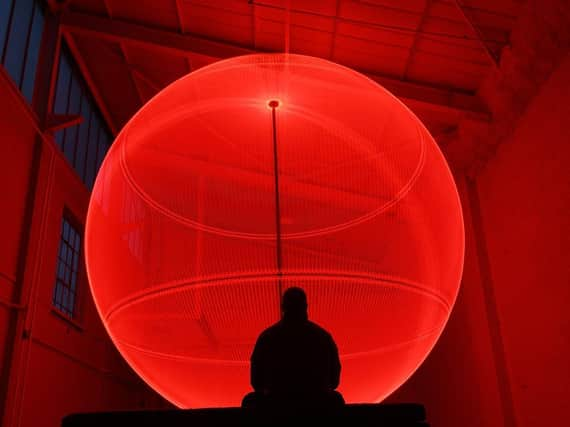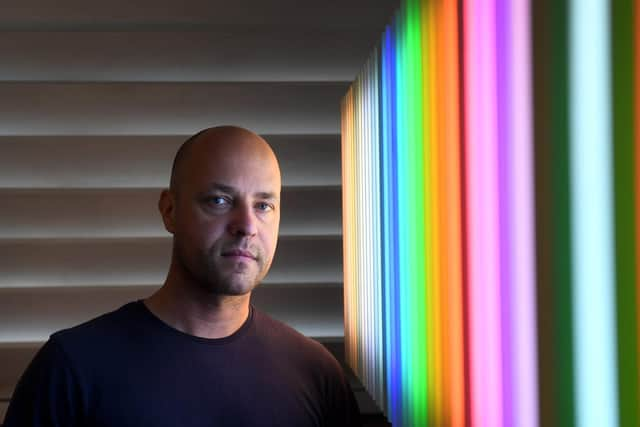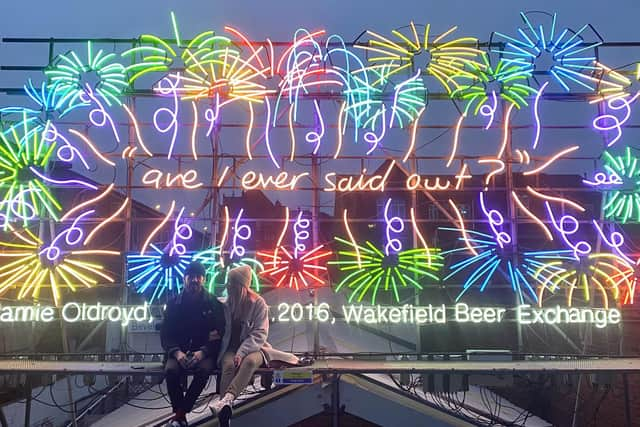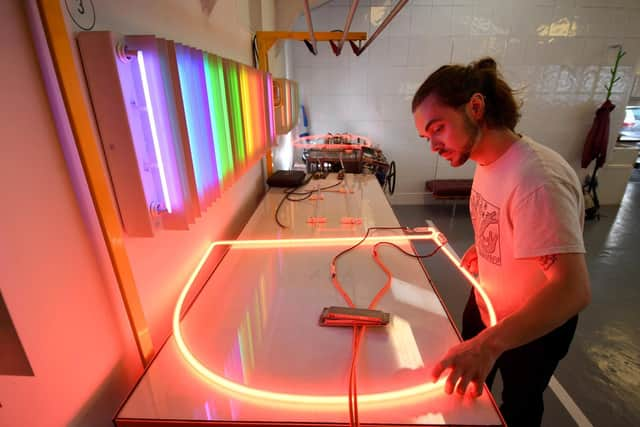Wakefield-based Neon Workshops is a master of bright lights


Neither men achieved the worldwide fame of contemporaries such as Thomas Edison, Marie Curie or Louis Pasteur.
The names of Ramsay and Travers were never – to use the old show-business phrase – up in lights.
Advertisement
Hide AdAdvertisement
Hide AdWhich is ironic, because in 1898 these were the men who discovered neon. Like so many brilliant men who have made amazing discoveries in their laboratories, it was for others to convert them to commercial enterprise. Had Ramsay and Travers received a single pound from every foot of neon lighting there has ever been in the world, they would probably have been the Jeff Bezos of their day.


Neon tubes were first used commercially in the early 1900s, when they first appeared on the front of a barber’s shop in the Montmartre district of Paris. From those rather humble beginnings, they have lit up everywhere from Las Vegas to Blackpool, and innumerable theatres, restaurants and nightclubs around the world.
No photos of that first sign remain, but there are some of the Paris Motor Show of 1910 – and in colour. They show that the neon was already sparking advertisers’ imaginations.
By the mid 1920s, there were at least 6,000 neon signs in the French capital, and this was also the decade where they first appeared in Los Angeles and then in London’s Piccadilly Circus.
Advertisement
Hide AdAdvertisement
Hide AdNeon signs have never been cheap. If you lit up a theatre to promote a new play or musical, and the show proved to be a resounding flop, producers would have been left out of pocket.


Ever since those early days, though, neon has lit up our world. “It has triggered a sense of the wonderful,” says Richard Wheater, head of the prestigious Neon Workshops in Wakefield, and the go-to expert in his field.
“However”, he adds: “Just as with so many other things, Britain is credited with the initial discovery, but we left the exploitation to others, many of whom made vast personal fortunes.”
Neon Workshops (celebrating its tenth year of business) is now one of the last specialists in the UK who do anything and everything with neon. They make signs, run workshops and masterclasses with neon experts, and also take bespoke commissions – signs of all sizes and designs for all manner of projects and events.
Advertisement
Hide AdAdvertisement
Hide AdThe work of Richard and his team is seen all over the world, in places as far apart as Australia and Switzerland.


Richard was born and raised in Wakefield and Neon Workshops has two bases in the city. One is home to the world’s most comprehensive archive of books on all things neon, and the other a warehouse space where the work is created.
So where does his passion for one of the rarest natural elements on earth come from? It turns out that Richard’s dad, a skilled plasterer and a man with an infinite curiosity, was having a post-work pint in his local one night, and the conversation had turned to some rather obtuse trivia. Armed with the information from a drinking pal that a dormant fluorescent tube would glow brightly if it was held underneath an electricity pylon Richard’s father excitedly returned home.
“He came into the bedroom that I shared with my younger brother Eric. He took the tube from a light fitting in the front room, and the three of us went down across the fields to find the nearest pylon, and we put this theory to the test. To our astonishment, it worked! The invisible energy triggered light.” Richard laughs: “We just didn’t question what dad was up to, it was all a bit of an adventure.”
Advertisement
Hide AdAdvertisement
Hide AdIf that night wasn’t quite a lightbulb moment, it did stay with him.
A few years later, at the age of 18, he went interrailing around Europe with one of his best friends.
“We went all over the place. Florence, Rome, Paris, you name it. And they all had a sort of flamboyance of art and architecture that I hadn’t seen before. Even as a teenage lad I realized that those things changed the ways that people lived.”
On returning home, Richard enrolled on a foundation course at nearby Dewsbury College, and met the inspirational tutor David Roberts.
Advertisement
Hide AdAdvertisement
Hide Ad“He was an amazing ceramicist and a very good teacher who pushed me hard,” he recalls.
“He was one of those people who appear at the right time in your life. It was David who urged me to get a portfolio together and to try to get into Edinburgh College of Art. To my surprise they accepted me, and they had a faculty that really excited me – because it specialised in glass.”
In 2000, he spent six months working and studying at Alfred University, in New York, as an exchange student.
“They’ve invested hugely in technology and their skills are recognized in the commercial world by organisations like NASA. It was a complete eye-opener for me, and it made me realise the potential of neon as an art form, because one of the teachers there is the amazing Fred Tschida, whose life has been devoted to creating ‘sculptures’ in this medium.”
Advertisement
Hide AdAdvertisement
Hide AdIt was seeing an exhibition of Tschida’s work that proved to be a key moment for Richard.
“Up to that point I used to enjoy neon when I saw it creatively used in signs, but Fred Tschida’s work took it out to another level, and I remember standing in front of his Sphere 2000 and being in complete awe. It is a huge circle in red, about three and a half metres across, rotating at about 30 rpm. With a long photographic exposure, it becomes a glowing sphere. It was so exciting to see.
"Later, I also learned that Tochida, a master of this genre of art, had never ever exhibited anywhere other than in the States. And that made me determined that, one day, we would remedy that appalling omission.”
The wheels were set in motion to bring several pieces of Tschida’s unique work to Britain – and specifically, to Wakefield, and to the innovative urban asset that is the Art House on Drury Lane, a short walk to the Neon premises.
Advertisement
Hide AdAdvertisement
Hide AdAnd this autumn it comes to fruition with seven of Tschida’s “beautifully engineered” pieces on show, over two floors at the Art House, including, in quite a coup, Sphere 2000 itself which will light up the warehouse space. This exhibition, CIRCLESPHERE, starts next week and runs until the end of November.
Richard, who is himself an artist, designer and entrepreneur with his business, hopes it will attract greater interest in neon.
“Leeds once had a thriving neon industry, with several firms open for business – they’re nearly all gone now, and we are, I suppose, a niche within a niche. But there is hope, because we’ve just installed a big sign for the House of Fu restaurant on the Headrow in Leeds. It’s a glorious five-metre-high glowing bowl of noodles! And yes, it definitely brightens up the surroundings.”
And talking of surroundings, is that pylon, where Richard’s love of all things neon began, still standing in the outskirts of Wakefield?
Advertisement
Hide AdAdvertisement
Hide Ad“Indeed it is,” he says, “And I pass it often. I’ve not, however, gone out there at night again. I’m probably getting a bit too old for that, and the security is far much tighter than back in the day… but for me, it’s still a bit of a personal landmark”.
CIRCLESPHERE runs at Wakefield Art House until November 28. For more information about Neon Workshops go to https://www.neonworkshops.com/